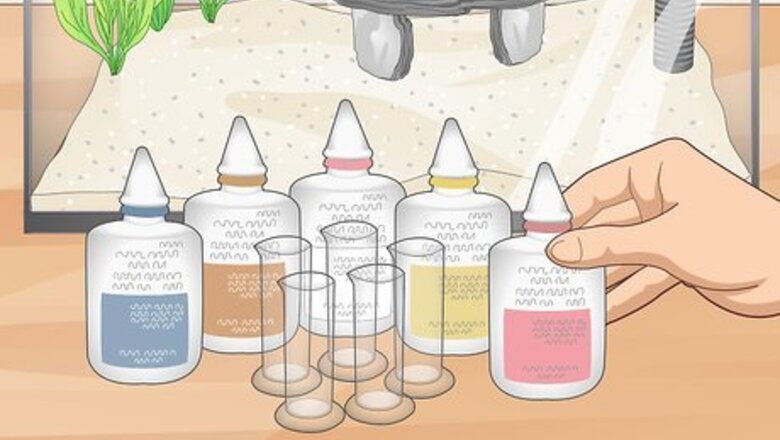
views
Testing the Water
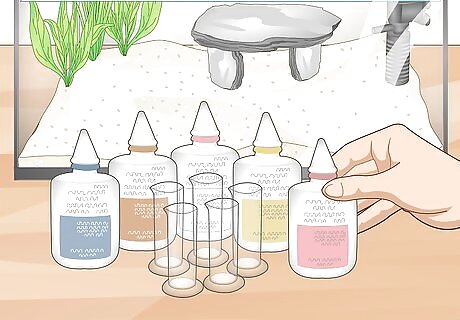
Buy testing strips or a test tube kit online or from any pet store. Go to a pet store or shop online for an aquarium water test kit that measures the pH of the water and tests for chlorine, ammonia, nitrates, nitrites, and phosphates. Be sure to read the label to make sure the test addresses all of these contaminants. Some kits don't test for chlorine, so if that's the case, pay attention to the reading for ammonia. If the water has any trace of ammonia (over 0 ppm), that's a sign there's chlorine in your water.Tip: Test the water once a week or whenever you notice it looks cloudy. That way, you can catch any high levels of contaminants before it becomes a bigger problem for your fish.
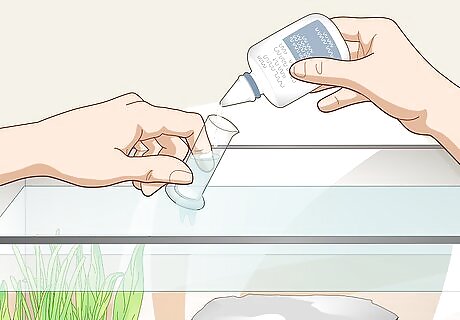
Fill the test tube with water from your aquarium and add chlorine test drops. Dip the tube into your aquarium to collect enough water to come up to the designated fill line on the tube. Refer to the kit's instruction manual to see how many drops of chlorine testing solution you should use (usually it’s about 3 drops). Put the cap on the tube when you’re done. If you’re testing for more than just chlorine, do this for all of the test tubes. If you're using test strips, dip it in the water and then set the strip down on a level surface.
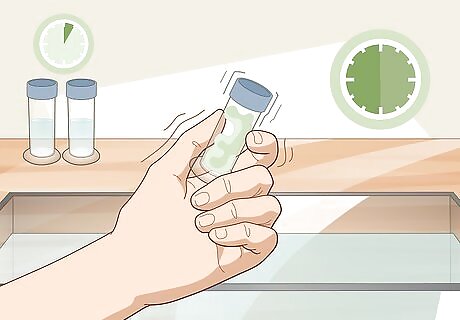
Shake each tube for 30-60 seconds and set a timer for 5 minutes. Shake up each tube so the testing solution gets fully incorporated into the water. Set the tubes somewhere safe for 5 minutes so the solution can set into the water and give you the most accurate results. If you’re using test strips, you’ll only need to wait 30 seconds. Refer to the kit’s instruction manual to see exactly long you should wait until the results are ready. If you’re testing for multiple things, keep the tubes in the same order that they appear on the results guide so you can keep track of which is which.
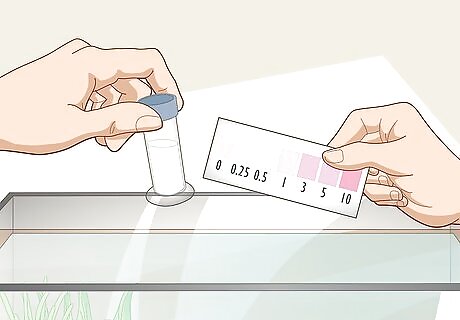
Match the color of the water in the chlorine testing tube to the results guide. Place the tube with the chlorine solution in it next to the results guide to see which color swatch matches the hue of the water. Make sure you're reading the result for the right type of water in your tank (freshwater or saltwater). If you’re testing for multiple contaminants or just the general pH and hardness of the water, be sure to align the correct tube with the corresponding swatches. The optimal levels for your fish tank are as follows: pH: 6.8 - 7.6 Ammonia: 0 ppm Chlorine: 0 ppm Nitrites: 0 ppm Nitrates: 20 - 40 ppm Phosphates: < 0.02 ppm Hardness: 5 - 12 dH (degrees) Alkalinity: 7 - 12 dKH
Treating the Water
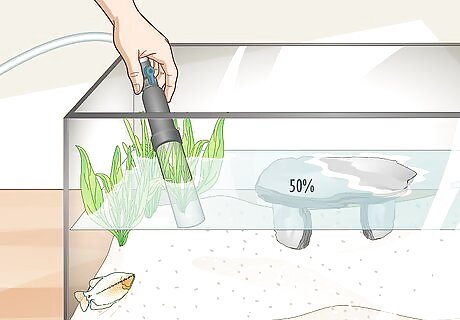
Remove 50% of the water from the tank. If you have a large tank, use a cup to scoop out half of the water in the tank. You can also use a gravel pump to suck the water out and into a nearby bucket. Be sure not to suck out any fish with it! For smaller tanks, you can simply lift it up and pour it out over the sink. If you're pouring the water out over the sink, be sure not to pour your fish out with it! Put a strainer or drain guard over the drain just in case. In most cases, it’ll suffice to change out 50% of the water every 2 weeks, but if you're changing all of the water, make a temporary tank for your fish. To do this, fill a container with 64 fluid ounces (1,900 mL) of water (roughly the same temperature as the tank water) and add 1 drop of water conditioner. Then use a net to add the fish.
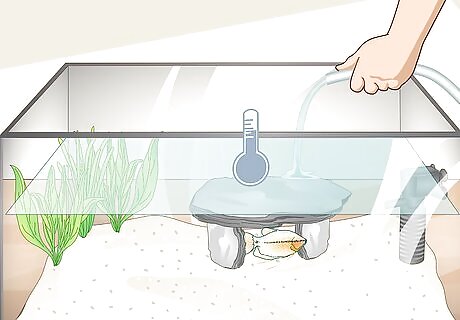
Add fresh tap water that’s the same temperature as the remaining tank water. Stick a thermometer into the remaining tank water to see what temperature it is. Turn on the hose or faucet and make sure the water is roughly that same temperature. Use a hose, bucket, or faucet to slowly add the water, pouring it in at one of the corners or sides so you don't stress out your fish or jostle any plants that are stationed in the gravel. It’s okay if the new water is 1 or 2 degrees off from the old water. The ideal temperature for most tanks is between 76°F and 80°F (25°C and 27°C).Tip: If you keep live plants in the tank, add aquarium plant fertilizer to keep them healthy. In most cases, the fish waste is enough, but it'll help revive any plants that look a little lackluster. Check the back of the fertilizer to see exactly how much you should add (it's usually per gallon, just like the water conditioner).
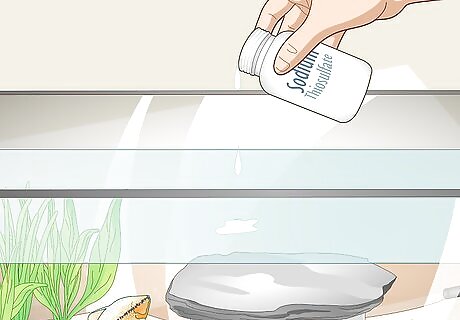
Use 1 drop of liquid sodium thiosulfate for each gallon of water you’ve added. Sodium thiosulfate is the most important thing you can do to get rid of chlorine in your tank water, so be sure to add the appropriate amount for however much new water you’ve added. In most cases, a single drop of the liquid is enough for 128 fluid ounces (3,800 mL), so check your tank size and divide it by 2 if you’re doing a 50% water change. For instance, if your tank holds 20 gallons (2560 liquid ounces or 75,708 mL), you’ll use 10 drops of sodium thiosulfate. Some types of conditioner recommend you use enough for all of the water in the tank, even if you’re only doing a 50% water change, so read the instructions on the bottle. If you're doing a full water change, add 1/2 of the dose once the tank is halfway full. Add the final dosage once it's completely full. You can buy sodium thiosulfate online or from pet stores or home improvement stores (it's also used to clean carpets).

Make your own water conditioner to keep on hand for future water changes. Place 500 g (by weight) of sodium thiosulfate flakes in a 128 fluid ounces (3,800 mL) jug and fill it with water. Shake it up and use 1 drop of the mixture for each 1 gallon of water in the tank. For instance, 0.03 fluid ounces (0.89 mL) of mix will treat 1,280 fluid ounces (10.0 US gal) This is a much more cost-effective way to dechlorinate your water if you have large tanks or plan to keep fish for years to come.
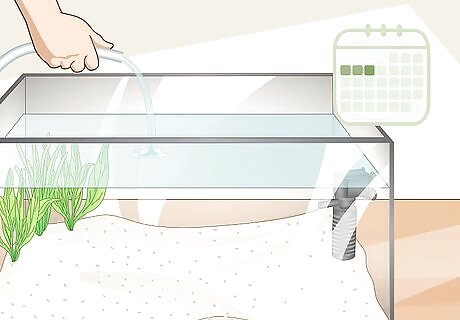
Fill the entire tank with tap water and wait for 2-3 days as an alternative. If you’re just starting your aquarium, fill the tank with regular tap water and let it sit for 2-3 before you add the fish. Be sure to cover it loosely with a clean towel to keep pests and debris out of the water. If you have a saltwater aquarium, let the freshwater sit a few days before you add the marine salt. Be sure to test the water before you add the fish. If there are any traces of chlorine left, add the appropriate amount of sodium thiosulfate. Keep in mind that if you’re working with saltwater, you’ll need to wait 24-48 hours to add the fish after you add the salt.Warning: Check your municipal water supplier’s consumer confidence report to see if they use chloramine (a combination of chlorine and ammonia) because it won't evaporate over time and is just as harmful to your fish. To find your water supplier's consumer confidence report, go to your city's government website or give them a call. If the water contains chloramine, you’ll need to treat it with sodium thiosulfate.

Use chlorine-free bottled water or well water as alternatives. If you have a smaller tank and don't mind the extra cost, fill your tank with bottled water. If you live near a clean water source like a pond or small private reservoir and have that piped into your home, use that. Just be sure that any filters you use in your home don't chlorinate the water to kill off microorganisms. If you do opt for well water, be sure to test it every week with testing strips. If you're going for the bottled water approach, you may need to remineralize the water to maintain the proper pH. Some kinds of bottled water may also contain chlorine and other contaminants, so be sure to test it regularly. Home carbon filtration systems (like Brita filters) say they can remove chlorine and chloramine, but some only get rid of the taste. If you fill your tank with tap water you filter yourself, always test it just in case.
Recognizing the Signs of Chlorine Toxicity
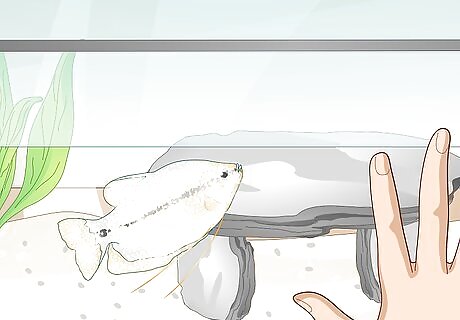
Examine your fish for overall paleness or red, mucus-coated gills. Healthy fish are vibrant in color and have clean gills, so looking at them is often the best way to make sure they’re happy and healthy. If you notice these signs, test the water right away and, if necessary, add sodium thiosulfate or change the water. Removing a fish from the tank stresses them out, which is not the best idea if you’re already dealing with a sick fish. Address the water first and then take more drastic action later on if the fish still looks ill. To remove the fish, fill a small container with 64 fluid ounces (1,900 mL) of water and add 1 drop of water conditioner. Use a net to put the fish into the separate tank while you get to work on changing the water in the aquarium.
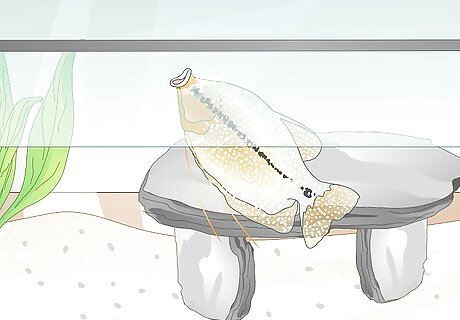
Notice if your fish are gasping for water at the top. If your fish seem to be bobbing at the top of the water and gasping for air (what’s known as hypoxia), chlorine could be messing up the amount of oxygen in the water. To fix the problem, change out half of the water and be sure to condition the new water you put in. You can also add a powerhead, air stones, or an additional filter to increase the amount of oxygen in the water. Hypoxia can also be caused by too much nitrogen or phosphorus, so be sure to test the water as soon as you notice this bobbing-and-gasping behavior.
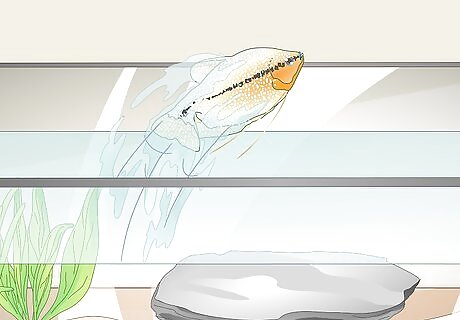
Pay attention to any erratic swimming or odd positioning. If your fish are leaping out the water or spastically moving their tail, fins, or mouth, take it as a sign that you need to change the water. Notice whether your fish are laying sideways in the tank as well. To help your fish recuperate, feed them nutritious meals like frozen bloodworms or live blackworms. Add an airstone or sponge filter to your tank to help them get the oxygen they need. Sick fish are more likely to be picked on by other fish, so if you notice one’s getting bullied, make sure they have some rock shelter so they can hide. If that’s not working, you may need to put them in their own small tank until they make a full recovery.










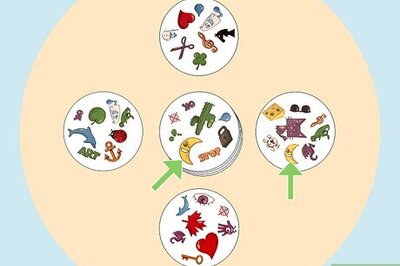




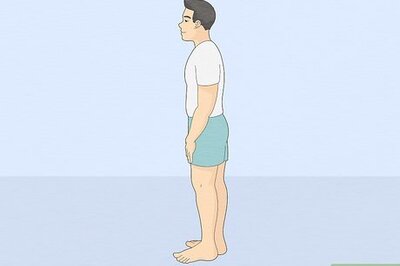



Comments
0 comment